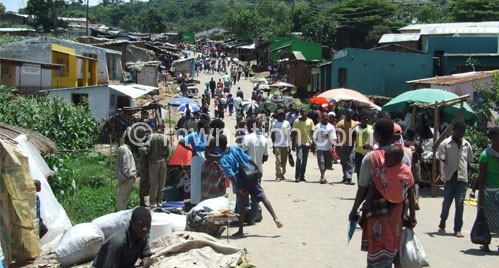Population rise a ticking bomb
In this interview EPHRAIM NYONDO talks to Dr Jesman Chintsanya, lecture of population studies at Chancellor College, on the continued rise of Malawi’s population.
Q: Malawi is said to have a high population growth rate in relation to the resources needed to support it. What are your views on this?
A: M a l a w i ’ s r a p i d population growth at 2.8 percent per annum poses challenges to the development of the country in that the total fertility rate, which is the average number of children a woman has in her lifetime, remains high and is declining very slowly. The recent 2014 Millennium Development Goals Endline Survey estimates it to be at five children per woman, a marginal decline from 5.7 children in 2010 and 6.4 children in 2000.Yet, the slow decline in fertility rate does not reflect the notable improvements in use of modern contraception among currently married women, which increased six-fold, from 7.4 percent in 1992 to 42.2 percent in 2010. Currently, the contraceptive prevalence rate is 58 percent. The increase in contraceptive prevalence without corresponding fertility rate decline shows that aspirations for high number of children among couples in Malawi remain strong.
In addition, the mismatch in contraceptive prevalence and high fertility is attributed to when women start using contraception late after having a high number of children already, use them predominantly for spacing and not for limiting purposes, and if discontinuation rates of contraception are high.
The current rate of population growth, age structure and spatial distribution of Malawi obviously has negative impacts on the development efforts of the country. Because of high fertility rates, the age structure of Malawi is youthful, meaning that the largest share of the population consists of the youth.
Malawi is at a very critical moment because mortality indicators are coming down; human survivorship has improved as witnessed in the increases in life expectancy from 48 years in 2008 to 53 years; lowering mortality of children under five, particularly children in their first days after their births.
What I am saying is that ignoring these population dynamic process and the momentum created by demographic processes puts ourselves in peril.

For policy makers whether they are in the ministries of Health, Education, or Home Affairs and are not thinking of the age structure of Malawi’s population, then they will be in big trouble. The potential of the country to develop lies in its ability to slow down the rapid population growth and reduce fertility rates.
Q: What is your opinion of Malawi’s legal and policy issues capacity to manage population in the country?
A: One of the reasons contributing to the high fertility in Malawi is that women marry early. As one way of preventing girls from marrying early and remaining longer in school, the Government of Malawi passed the Marriage, Divorce and Family Relations Bill in February 2015. The law was passed to provide enough rights to protect female children as well as addressing early marriage practices sanctioned by many ethnic groups, by raising the minimum age of marriage from 14 to 18 years. Nevertheless, the law fails to implement punitive measures if minors marry contrary to the stipulations of the law, and therefore the legal framework to control fertility remains weak in this aspect. In addition, there are no institutional structures to promote girls education, especially at elementary level such that girls have few opportunities to further their educational career and, not surprisingly, drop out after elementary education.
Q: The issue of family planning has been cited as one of methods that can help reduce population growth in the country. What is your assessment of family planning interventions in the country and what more do you think need to be done?
A: For sure, the Malawi Government has made various reforms, which aim at improving family planning services delivery in the country. These reforms align to the recommendations of the various international policies to which Malawi is a signatory, which include the 1994 International Conference on Population and Development (ICPD) and the Maputo Plan of Action, both of which relate to the promotion of sexual and reproductive health and rights (SRHR). For example, in 2002 government of Malawi affirmed its commitments to the earlier declarations by implementing the SRHR policy in line with the National Health Reproduction Programme. The overall goal of the programme is to promote SRHR through informed choice, and safe Reproductive Health (RH) practices by men, women and youths, including use of quality and accessible RH services. The result of the reforms was to provide easy access to the family planning services.
Generally the focus in Malawi has been on the family planning supply side and not on reducing the demand for children. This position may be the case given that the government of Malawi emphasised preventing pregnancies for the health of the mother and the child.
Another factor may be that it was easier for government agencies to manage and implement such programmes with support from the donors. In contrast, it is difficult to motivate people to have fewer children given the high mortality levels. Thus the focus concentrated on supplying contraceptives, with a view to reducing the demand for children, but without necessarily changing the cultural factors that make people want high numbers of children.
Q: Is there anything you would want to add?
A: It is certainly true that the government of Malawi and development partners such as the United Nations agencies notably the UNFPA’s support on Youth Friendly Health Service Initiative, which aims at expanding access and availability of contraceptives among the youth, significantly shaped the contraceptive prevalence rate in Malawi. Nevertheless, young women face numerous barriers to accessing health services; youth show a knowledge gap in young people’s health issues, and services are often inadequate. Therefore youth remain a marginalised group in relation to family planning in Malawi and there is need to remove these impediments.
If the country is to develop, there is need to reduce fertility rates by addressing these issues and making investments in family planning since this is much more cost effective than other development strategies. Reducing population growth is also viewed as a major solution to the environmental problems ranging from resource scarcity to environmental degradation and now even climate change. n





